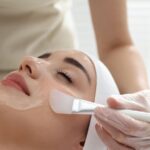
Types of Chemical Peels: Your Complete Guide to Skin Transformation
September 2, 2025
Discover the Best Facials Near You: Your Complete Guide to Glowing Skin in Coral Gables, FL
September 4, 2025If you’re struggling with dark spots, melasma, or uneven skin tone, you’re not alone. Hyperpigmentation affects millions of people, causing frustration and diminished confidence. The good news? Finding the best chemical peel for hyperpigmentation can transform your skin and restore your natural glow.
At Pōk Aesthetic Bar, located in the heart of Coral Gables, Florida, we’ve helped countless clients achieve radiant, even-toned skin through expertly administered chemical peels. Our board-certified professionals understand that choosing the right treatment is crucial for both safety and results.
Understanding Hyperpigmentation: The Root of Uneven Skin 🎯
Hyperpigmentation occurs when your skin produces excess melanin, creating dark patches or spots that can appear anywhere on your face or body. Common triggers include:
- Sun damage from UV exposure
- Hormonal changes during pregnancy or menopause
- Acne scarring and post-inflammatory responses
- Age-related melanin accumulation
- Genetic predisposition to pigmentation disorders
The psychological impact extends beyond appearance—studies show that 78% of people with visible hyperpigmentation report feeling self-conscious in social situations. This emotional toll makes finding effective treatment even more critical.
Why Chemical Peels Are the Gold Standard for Hyperpigmentation Treatment
Chemical peels work by removing damaged skin layers and stimulating cellular renewal. Unlike topical creams that may take months to show results, the best chemical peel for hyperpigmentation can deliver visible improvements in just one session.
Key benefits include:
- Accelerated cell turnover removes pigmented cells
- Improved texture and skin smoothness
- Enhanced product absorption for better skincare results
- Stimulated collagen production for anti-aging benefits
- Customizable intensity based on your specific needs
Types of Chemical Peels: Finding Your Perfect Match
Light Chemical Peels (Superficial)
Glycolic Acid Peels represent the most popular choice for treating mild hyperpigmentation. With minimal downtime and gentle exfoliation, these peels are perfect for beginners or those with sensitive skin.
Benefits:
- Safe for all skin types
- Minimal recovery time (24-48 hours)
- Can be performed monthly
- Gradual, natural-looking results
Lactic Acid Peels offer similar benefits with added hydration properties, making them ideal for dry or mature skin experiencing pigmentation issues.
Medium Chemical Peels
TCA (Trichloroacetic Acid) Peels penetrate deeper than light peels, making them highly effective for moderate to severe hyperpigmentation. The best chemical peel for hyperpigmentation in this category often combines TCA with other acids for enhanced results.
Jessner’s Peels blend salicylic acid, lactic acid, and resorcinol to target multiple skin concerns simultaneously. These peels excel at treating:
- Stubborn melasma
- Sun damage
- Age spots
- Post-acne hyperpigmentation
Deep Chemical Peels
Phenol Peels represent the most intensive option, reserved for severe hyperpigmentation cases. While highly effective, these require extensive downtime and careful post-treatment care.
The Science Behind Effective Pigmentation Treatment 🧪
Understanding how chemical peels work helps you make informed decisions. When applied, acids break down the bonds between dead skin cells, allowing them to shed more rapidly. This process:
- Removes pigmented cells from the skin’s surface
- Stimulates new cell growth with less melanin concentration
- Improves cellular communication for better melanin distribution
- Enhances skin barrier function to prevent future damage
Research published in the Journal of Cosmetic Dermatology shows that patients using chemical peels for hyperpigmentation see 60-80% improvement in pigmentation after 3-6 treatments.
Chemical Peel Comparison: Making the Right Choice
| Peel Type | Best For | Downtime | Sessions Needed | Cost Range |
| Glycolic Acid | Mild pigmentation, sensitive skin | 1-2 days | 6-8 sessions | $75-150 |
| Lactic Acid | Dry skin with pigmentation | 1-3 days | 6-8 sessions | $80-160 |
| TCA | Moderate to severe pigmentation | 5-7 days | 3-4 sessions | $150-400 |
| Jessner’s | Multiple skin concerns | 5-10 days | 3-5 sessions | $200-500 |
| Phenol | Severe pigmentation | 14-21 days | 1-2 sessions | $600-1500 |
Preparing for Your Chemical Peel Treatment
Success with the best chemical peel for hyperpigmentation begins before your appointment. Proper preparation ensures optimal results and minimizes complications:
2-4 Weeks Before:
- Stop using retinoids and exfoliating products
- Begin using gentle, fragrance-free skincare
- Apply broad-spectrum SPF 30+ daily
- Avoid waxing or aggressive hair removal
1 Week Before:
- Discontinue any new skincare products
- Inform your provider about medications and supplements
- Avoid direct sun exposure
- Stay well-hydrated for optimal healing
What to Expect During Your Chemical Peel Session
Professional chemical peel administration ensures safety and efficacy. Here’s the typical process:
Pre-treatment Assessment (15 minutes):
- Skin analysis and pigmentation mapping
- Discussion of realistic expectations
- Final treatment selection
Application Process (15-30 minutes):
- Thorough skin cleansing
- Precise acid application
- Real-time monitoring for optimal results
- Neutralization when appropriate
Post-treatment Care (10 minutes):
- Immediate soothing treatment application
- Detailed aftercare instructions
- Follow-up appointment scheduling
Post-Peel Care: Maximizing Your Results ✨
The period following your chemical peel is crucial for achieving the best results. Proper aftercare can mean the difference between good and exceptional outcomes.
First 24-48 Hours:
- Keep skin cool and hydrated with gentle moisturizers
- Avoid makeup to allow skin to heal
- Use only recommended cleansers to prevent irritation
- Apply ice packs for any discomfort
Week 1-2:
- Moisturize frequently to support healing
- Avoid picking or peeling skin manually
- Use gentle, lukewarm water for cleansing
- Sleep with your head elevated to reduce swelling
Long-term Maintenance:
- Daily sunscreen application (SPF 30 minimum)
- Regular moisturizing routine
- Gentle exfoliation only after complete healing
- Professional follow-up treatments as recommended
Potential Side Effects and How to Minimize Risks
While chemical peels are generally safe, understanding potential side effects helps you prepare:
Common, Expected Effects:
- Temporary redness and sensitivity
- Mild swelling for 24-48 hours
- Skin peeling for 3-7 days
- Temporary darkening before improvement
Rare but Serious Complications:
- Infection (less than 1% of cases)
- Scarring with improper aftercare
- Hyperpigmentation in darker skin tones
- Allergic reactions to specific acids
Choosing an experienced provider like Pōk Aesthetic Bar significantly reduces these risks through proper assessment, technique, and aftercare guidance.
The Investment: Cost Considerations and Value
When evaluating the best chemical peel for hyperpigmentation, consider both immediate costs and long-term value:
Financial Investment:
- Light peels: $75-200 per session
- Medium peels: $150-500 per session
- Deep peels: $600-1500 per session
Hidden Value:
- Reduced makeup costs from improved skin confidence
- Enhanced professional appearance boosting career prospects
- Improved self-esteem and social confidence
- Prevention of further damage saving future treatment costs
Many clients find that investing in professional chemical peels actually saves money compared to endless cycles of over-the-counter products that deliver minimal results.
Alternative Treatments: How Chemical Peels Compare
Understanding your options helps you choose the best chemical peel for hyperpigmentation versus other treatments:
Laser Therapy:
- Higher cost ($300-800 per session)
- More dramatic results but increased downtime
- Risk of hyperpigmentation in darker skin
- Requires specialized equipment and training
Microneedling with PRP:
- Similar cost to medium peels
- Great for texture but slower pigmentation results
- Combines well with chemical peels
- Minimal downtime but requires multiple sessions
Prescription Topicals:
- Lower upfront cost but slower results
- Requires 3-6 months of consistent use
- May cause irritation or sensitivity
- Less dramatic improvement than professional treatments
Professional vs. At-Home Peels: Why Expertise Matters 🏥
While at-home peels offer convenience, professional treatments provide superior safety and results:
Professional Advantages:
- Customized acid concentrations for your specific needs
- Real-time monitoring during application
- Proper pH formulations for maximum efficacy
- Emergency protocols if complications arise
- Comprehensive aftercare support
At-Home Limitations:
- Lower acid concentrations limit effectiveness
- Risk of over-application or uneven results
- No professional guidance for complications
- Generic formulations may not address your specific concerns
For the best chemical peel for hyperpigmentation results, professional administration ensures both safety and optimal outcomes.
Conclusion: Your Journey to Radiant, Even-Toned Skin
Choosing the best chemical peel for hyperpigmentation requires careful consideration of your skin type, pigmentation severity, lifestyle, and budget. Whether you opt for gentle glycolic acid treatments or more intensive TCA peels, the key is working with experienced professionals who can guide you toward optimal results.
Remember, treating hyperpigmentation is a journey, not a destination. Consistent professional treatments, proper skincare, and diligent sun protection will help you maintain your beautiful results for years to come.
The investment in your skin’s health and appearance pays dividends in confidence, professional success, and overall quality of life. With the right approach and professional guidance, clear, radiant skin is within reach.
Frequently Asked Questions
Q: How long does it take to see results from the best chemical peel for hyperpigmentation?
A: Light peels show gradual improvement over 4-6 weeks, while medium peels can deliver noticeable results within 7-14 days. Full results typically develop over 2-3 months as new skin cells regenerate.
Q: Can I get chemical peels if I have dark skin?
A: Yes, but it requires specialized expertise. Darker skin tones have higher risk of post-inflammatory hyperpigmentation, so choosing an experienced provider is crucial for safe, effective treatment.
Q: How often should I get chemical peels for hyperpigmentation?
A: Light peels can be performed every 4-6 weeks, medium peels every 3-4 months, and deep peels are typically one-time treatments. Your provider will create a personalized treatment schedule.
Q: What is the best chemical peel for hyperpigmentation on sensitive skin?
A: Lactic acid peels are often the best choice for sensitive skin, offering effective pigmentation treatment with minimal irritation and added hydrating benefits.
Q: Can chemical peels completely remove hyperpigmentation?
A: While chemical peels can significantly improve hyperpigmentation (60-90% reduction), complete removal depends on the type, depth, and age of the pigmentation. Maintenance treatments help sustain results.
People Also Ask
What chemical peel is most effective for melasma? TCA peels and Jessner’s peels are most effective for melasma, as they penetrate deeper to address hormonal pigmentation. However, treatment must be carefully managed to avoid rebound hyperpigmentation.
Are chemical peels safe during pregnancy? Most chemical peels are not recommended during pregnancy due to increased skin sensitivity and potential absorption concerns. Gentle glycolic acid peels may be considered after the first trimester with physician approval.
How much does the best chemical peel for hyperpigmentation cost? Costs range from $75-200 for light peels to $600-1500 for deep peels. Most patients need 3-6 sessions for optimal results, making the total investment $300-1200 for most treatment plans.
Can I combine chemical peels with other treatments? Yes, chemical peels combine well with microneedling, laser therapy, and prescription topicals. However, timing and sequencing must be carefully planned to avoid over-treatment and complications.
What’s the difference between at-home and professional chemical peels? Professional peels use higher acid concentrations (20-70%) versus at-home versions (5-15%), provide customized formulations, and include expert monitoring for safety and optimal results.
Ready to transform your skin with the best chemical peel for hyperpigmentation? Contact Pōk Aesthetic Bar in Coral Gables, FL today to schedule your personalized consultation. Our expert team at 4649 Ponce de Leon Blvd, Suite 406, Coral Gables, FL 33146 is ready to help you achieve the clear, radiant complexion you deserve.

